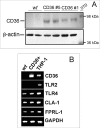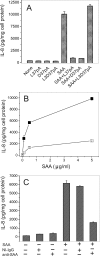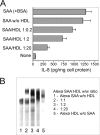CD36 is a novel serum amyloid A (SAA) receptor mediating SAA binding and SAA-induced signaling in human and rodent cells
- PMID: 20075072
- PMCID: PMC2832998
- DOI: 10.1074/jbc.M109.007526
CD36 is a novel serum amyloid A (SAA) receptor mediating SAA binding and SAA-induced signaling in human and rodent cells
Abstract
Serum amyloid A (SAA) is a major acute phase protein involved in multiple physiological and pathological processes. This study provides experimental evidence that CD36, a phagocyte class B scavenger receptor, functions as a novel SAA receptor mediating SAA proinflammatory activity. The uptake of Alexa Fluor 488 SAA as well as of other well established CD36 ligands was increased 5-10-fold in HeLa cells stably transfected with CD36 when compared with mock-transfected cells. Unlike other apolipoproteins that bind to CD36, only SAA induced a 10-50-fold increase of interleukin-8 secretion in CD36-overexpressing HEK293 cells when compared with control cells. SAA-mediated effects were thermolabile, inhibitable by anti-SAA antibody, and also neutralized by association with high density lipoprotein but not by association with bovine serum albumin. SAA-induced cell activation was inhibited by a CD36 peptide based on the CD36 hexarelin-binding site but not by a peptide based on the thrombospondin-1-binding site. A pronounced reduction (up to 60-75%) of SAA-induced pro-inflammatory cytokine secretion was observed in cd36(-/-) rat macrophages and Kupffer cells when compared with wild type rat cells. The results of the MAPK phosphorylation assay as well as of the studies with NF-kappaB and MAPK inhibitors revealed that two MAPKs, JNK and to a lesser extent ERK1/2, primarily contribute to elevated cytokine production in CD36-overexpressing HEK293 cells. In macrophages, four signaling pathways involving NF-kappaB and three MAPKs all appeared to contribute to SAA-induced cytokine release. These observations indicate that CD36 is a receptor mediating SAA binding and SAA-induced pro-inflammatory cytokine secretion predominantly through JNK- and ERK1/2-mediated signaling.
Figures












Similar articles
-
Serum amyloid A binding to CLA-1 (CD36 and LIMPII analogous-1) mediates serum amyloid A protein-induced activation of ERK1/2 and p38 mitogen-activated protein kinases.J Biol Chem. 2005 Mar 4;280(9):8031-40. doi: 10.1074/jbc.M405009200. Epub 2004 Dec 2. J Biol Chem. 2005. PMID: 15576377
-
Human SR-BII mediates SAA uptake and contributes to SAA pro-inflammatory signaling in vitro and in vivo.PLoS One. 2017 Apr 19;12(4):e0175824. doi: 10.1371/journal.pone.0175824. eCollection 2017. PLoS One. 2017. PMID: 28423002 Free PMC article.
-
The ω-carboxyl group of 7-ketocholesteryl-9-carboxynonanoate mediates the binding of oxLDL to CD36 receptor and enhances caveolin-1 expression in macrophages.Int J Biochem Cell Biol. 2017 Sep;90:121-135. doi: 10.1016/j.biocel.2017.07.022. Epub 2017 Aug 5. Int J Biochem Cell Biol. 2017. PMID: 28789920
-
Immune functions of serum amyloid A.Crit Rev Immunol. 2012;32(4):335-48. doi: 10.1615/critrevimmunol.v32.i4.40. Crit Rev Immunol. 2012. PMID: 23237509 Review.
-
CD36 as a multiple-ligand signaling receptor in atherothrombosis.Cardiovasc Hematol Agents Med Chem. 2011 Jan;9(1):42-55. doi: 10.2174/187152511794182855. Cardiovasc Hematol Agents Med Chem. 2011. PMID: 20939828 Review.
Cited by
-
Role of Serum Amyloid A in Abdominal Aortic Aneurysm and Related Cardiovascular Diseases.Biomolecules. 2021 Dec 15;11(12):1883. doi: 10.3390/biom11121883. Biomolecules. 2021. PMID: 34944527 Free PMC article. Review.
-
High-density lipoprotein inhibits serum amyloid A-mediated reactive oxygen species generation and NLRP3 inflammasome activation.J Biol Chem. 2018 Aug 24;293(34):13257-13269. doi: 10.1074/jbc.RA118.002428. Epub 2018 Jul 5. J Biol Chem. 2018. PMID: 29976759 Free PMC article.
-
OxLDL or TLR2-induced cytokine response is enhanced by oxLDL-independent novel domain on mouse CD36.Immunol Lett. 2011 Jun 30;137(1-2):15-27. doi: 10.1016/j.imlet.2011.01.015. Epub 2011 Jan 31. Immunol Lett. 2011. PMID: 21281677 Free PMC article.
-
The cytokine-serum amyloid A-chemokine network.Cytokine Growth Factor Rev. 2016 Aug;30:55-69. doi: 10.1016/j.cytogfr.2015.12.010. Epub 2015 Dec 28. Cytokine Growth Factor Rev. 2016. PMID: 26794452 Free PMC article. Review.
-
Regulation of Atherosclerosis by Toll-Like Receptor 4 Induced by Serum Amyloid 1: A Systematic In Vitro Study.Biomed Res Int. 2022 Sep 15;2022:4887593. doi: 10.1155/2022/4887593. eCollection 2022. Biomed Res Int. 2022. PMID: 36158875 Free PMC article.
References
-
- Kushner I., Rzewnicki D. L. (1994) Baillieres Clin. Rheumatol. 8, 513–530 - PubMed
-
- Kushner I. (1982) Ann. N.Y. Acad. Sci. 389, 39–48 - PubMed
-
- Uhlar C. M., Whitehead A. S. (1999) Eur. J. Biochem. 265, 501–523 - PubMed
-
- Malle E., Steinmetz A., Raynes J. G. (1993) Atherosclerosis 102, 131–146 - PubMed
-
- Patel H., Fellowes R., Coade S., Woo P. (1998) Scand. J. Immunol. 48, 410–418 - PubMed
Publication types
MeSH terms
Substances
Grants and funding
LinkOut - more resources
Full Text Sources
Other Literature Sources
Molecular Biology Databases
Research Materials
Miscellaneous

